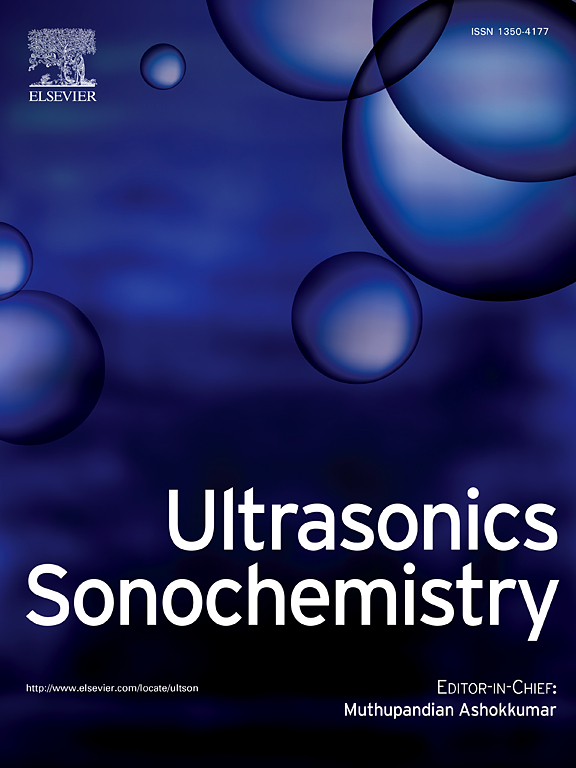Utilizing ultrasound for the extraction of polysaccharides from the tuber of Typhonium giganteum Engl.: Extraction conditions, structural characterization and bioactivities
IF 8.7
1区 化学
Q1 ACOUSTICS
引用次数: 0
Abstract
Polysaccharides from the dried tuber of Typhonium giganteum Engl. (TGEPs) were obtained by utilizing ultrasonic-assisted extraction (UAE) as the extraction method. The determination of optimal process parameters for the UAE of TGEPs (TGEP-U) was accomplished through the application of response surface methodology (RSM). The structural characteristics, antioxidant and hypoglycemic effects of TGEP-U and TGEPs obtained by hot water extraction (TGEP-H) were then compared. Consequently, the optimum extraction conditions predicted by RSM for TGEP-U were obtained as adding water at a ratio of 31 mL/g and extracted for 32 min under an ultrasound power of 440 W. In the verification experiment, the actual yield of TGEP-U was 7.32 ± 0.18 %. It was found that UAE could increase the yield and the total sugar content of TGEPs. Meanwhile, chemical composition analysis showed that both TGEP-U and TGEP-H were mainly composed of mannose, rhamnose, glucuronic acid, galacturonic acid, glucose, galactose, arabinose, and fucose, but the monosaccharide molar ratios were changed by UAE. Analysis of molecular weight (Mw) revealed the presence of three primary constituents within TGEP-U, and four main components in TGEP-H, and UAE reduced the average Mw of TGEPs. No obvious difference was found in the Fourier transform infrared spectroscopy analysis of TGEP-U and TGEP-H. The Congo red and Circular dichroism tests demonstrated that TGEP-U and TGEP-H had non-three helical structure. Scanning electron microscope observation further revealed that the aggregation of functional groups within TGEPs may be influenced by ultrasound, thereby affecting their powder morphology. TGEP-U has slightly poorer thermal stability than TGEP-H, which may be affected by ultrasonic cavitation effects. The results also indicated that TGEP-U had better antioxidant and hypoglycemic activity than TGEP-H. In summary, UAE is an effective method to extract and enhance the activity of TGEPs with enormous research value and potentials.

求助全文
约1分钟内获得全文
求助全文
来源期刊

Ultrasonics Sonochemistry
化学-化学综合
CiteScore
15.80
自引率
11.90%
发文量
361
审稿时长
59 days
期刊介绍:
Ultrasonics Sonochemistry stands as a premier international journal dedicated to the publication of high-quality research articles primarily focusing on chemical reactions and reactors induced by ultrasonic waves, known as sonochemistry. Beyond chemical reactions, the journal also welcomes contributions related to cavitation-induced events and processing, including sonoluminescence, and the transformation of materials on chemical, physical, and biological levels.
Since its inception in 1994, Ultrasonics Sonochemistry has consistently maintained a top ranking in the "Acoustics" category, reflecting its esteemed reputation in the field. The journal publishes exceptional papers covering various areas of ultrasonics and sonochemistry. Its contributions are highly regarded by both academia and industry stakeholders, demonstrating its relevance and impact in advancing research and innovation.
 求助内容:
求助内容: 应助结果提醒方式:
应助结果提醒方式:


